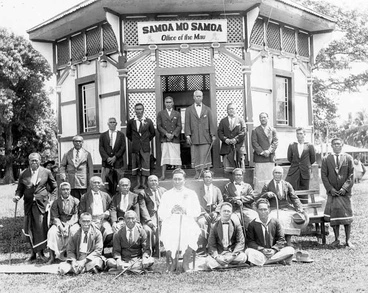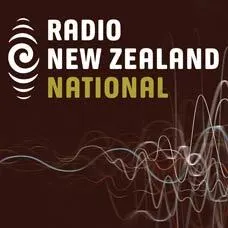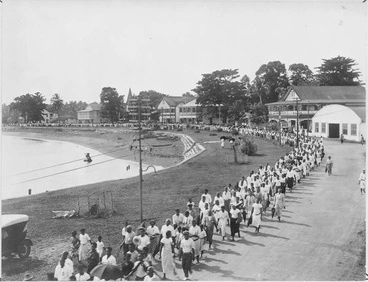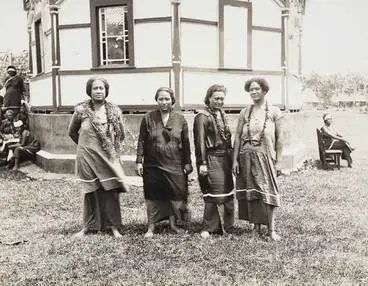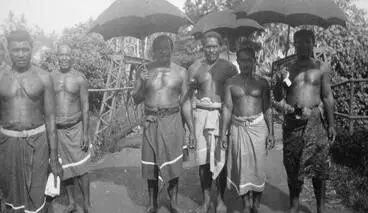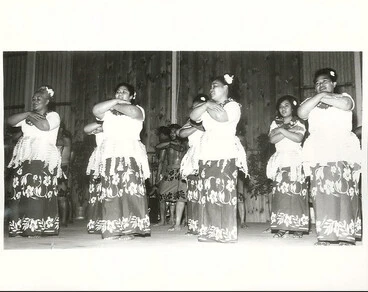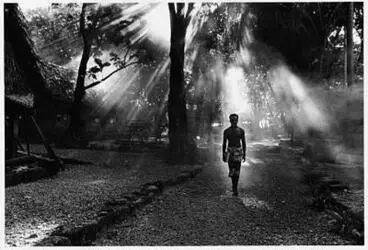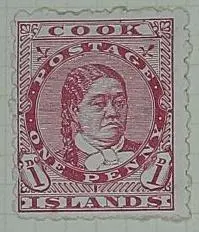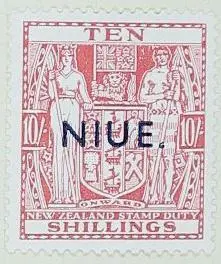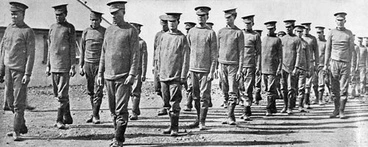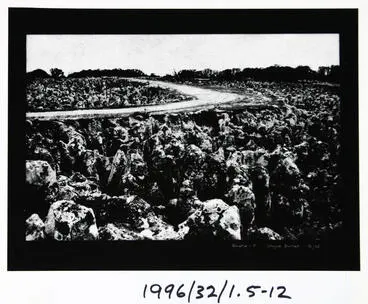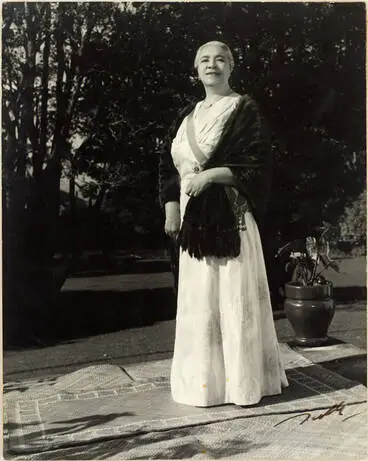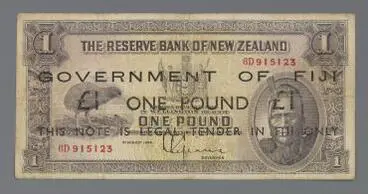Post-Colonial Pacific Independence
A DigitalNZ Story by National Library Services to Schools
Decolonisation of the Pacific island nations largely occurred from the mid 20th century, particularly from the 1960s to the 1980s.
PACIFIC COLONISATION
Decolonisation of the Pacific island nations largely occurred from the mid 20th century, particularly from the 1960s to the 1980s, when many of the island nations regained their independence.
Celebration of Samoa’s Independence Day
Manatū Taonga, the Ministry for Culture and Heritage
SAMOA
In 1962 Samoa became the first Pacific island state to regain its independence. A new constitution was accompanied by a Treaty of Friendship that guaranteed New Zealand assistance in areas such as foreign affairs and defence. On 9 May 1961, 83% of voters had backed the constitution in a referendum supervised by the United Nations.
Source: Pacific Islands and New Zealand - Samoa, Te Ara - the Encyclopedia of New Zealand
The banishment of Tupua Tamasese Lealofi III
Manatū Taonga, the Ministry for Culture and Heritage
MAU REBELLION
Samoa has a history of opposition to European rule. Formal resistance had occurred on two occasions during the German colonial era, and several petitions had already challenged New Zealand's administration. But the opposition that emerged in the late 1920s was organised and widespread.
In March 1927, the Citizens' Committee confirmed the principles of an organisation called the League of Samoa. It became known as O le Mau a Samoa - ‘the firm opinion of Samoa’ - the Mau. Its slogan, Samoa Mo Samoa – ‘Samoa for Samoans’ – envisaged a Samoa without New Zealand.
Source: New Zealand in Samoa - The rise of the Mau movement, NZHistory
Samoa's 52nd Independence anniversary
Radio New Zealand
Mau parade
Manatū Taonga, the Ministry for Culture and Heritage
Women Mau leaders
Manatū Taonga, the Ministry for Culture and Heritage
Leaflet, 'Ia Samoa Uma'
Museum of New Zealand Te Papa Tongarewa
Mau supporters in 1930
Manatū Taonga, the Ministry for Culture and Heritage
Mau insignia
Manatū Taonga, the Ministry for Culture and Heritage
UN-supervised referendum, Tokelau
Manatū Taonga, the Ministry for Culture and Heritage
TOKELAU
New Zealand assumed control over the Tokelau Islands from Britain in 1926, and incorporated them within the territorial boundaries of New Zealand in 1948. Tokelau, which had fewer than 2,000 people on its three atolls, voted in 2006 on the proposal that the territory become a self-governing state in free association with New Zealand. 349 registered voters were in favour – 60.1%, short of the required two-thirds majority. A second referendum in 2007 obtained the support of 697 voters (64.4%) – 16 fewer than needed.
In 2020 Tokelau remained a New Zealand dependent territory.
Source: Pacific Islands and New Zealand - Cook Islands, Niue, Tokelau and Nauru, Te Ara - the Encyclopedia of New Zealand
Tokelau Islanders from Wellington, Polynesian Festival 1972
Archives New Zealand Te Rua Mahara o te Kāwanatanga
Aerial shot of Nukunonu, Tokelau
Museum of New Zealand Te Papa Tongarewa
Fakaofo, Tokelau (I) 1971
Auckland Art Gallery Toi o Tāmaki
Niue and New Zealand, 2004
Manatū Taonga, the Ministry for Culture and Heritage
COOK ISLANDS AND NIUE
The Cook Islands, taken under a British protectorate in 1888, became New Zealand’s first South Pacific Island colony in 1901.
The Cook Islands secured territorial self-government through a ‘free association‘ agreement with New Zealand on 4 August 1965. Niue established a similar arrangement on 19 October 1974. Both adopted constitutions that empowered ‘Her Majesty the Queen in Right of New Zealand’, and both remained part of ‘Our Realm of New Zealand’2.
Source: Pacific Islands and New Zealand - Cook Islands, Niue, Tokelau and Nauru, Te Ara - the Encyclopedia of New Zealand
Stamp: Cook Islands One Penny
Canterbury Museum
Cook Islanders, Cook Islands
Alexander Turnbull Library
Tangaroa – Cook Islands
Manatū Taonga, the Ministry for Culture and Heritage
Stamp: New Zealand - Niue Ten Shillings
Canterbury Museum
Niue Island recruits
Manatū Taonga, the Ministry for Culture and Heritage
Five Dollars Niue Islands
Deutsche Digitale Bibliothek
Nauru stripped
Manatū Taonga, the Ministry for Culture and Heritage
NAURU
After the First World War, New Zealand shared in the British Empire mandate over Nauru (previously controlled by Germany). The mandate, administered by Australia, guaranteed a plentiful and cheap supply of the island’s phosphates to assist New Zealand agriculture. In 1968 Nauru became the second Pacific Island state to obtain independence.
Source: Pacific Islands and New Zealand - Cook Islands, Niue, Tokelau and Nauru, Te Ara - the Encyclopedia of New Zealand
Nauru (cantilever)
Museum of New Zealand Te Papa Tongarewa
Nauru
Alexander Turnbull Library
Nauru:5
Te Whare o Rehua Sarjeant Gallery
Fijian independence celebrations, 1970
Manatū Taonga, the Ministry for Culture and Heritage
FIJI AND TONGA
Both Fiji and Tonga were drawn into the British sphere of influence – Fiji was a colony from 1874 and Tonga was under British protection from 1900. Both gained full independence in 1970, as Britain gradually withdrew from the Pacific.
Source: Pacific Islands and New Zealand - Fiji and Tonga, Te Ara - the Encyclopedia of New Zealand
Queen Sālote of Tonga, 1960s
Auckland Libraries
The Duke of Edinburgh, Queen Sālote Tupou III, Rev A.E. McKay and Queen Elizabeth II, Royal Tour, Tonga
Museum of New Zealand Te Papa Tongarewa
Carte philatelique (Tonga)
Museum of New Zealand Te Papa Tongarewa
[Selection of four newsclippings about Tonga and Tongans. 1938-1939]
Alexander Turnbull Library
Fijian Independence (picture including Keith Holyoake & Prince Charles)
Archives New Zealand Te Rua Mahara o te Kāwanatanga
Banknote, 1 Pound overprint, New Zealand / Fiji
Powerhouse Museum
Carte philatelique (Fiji)
Museum of New Zealand Te Papa Tongarewa
Group from Fiji, Sixth Festival of Pacific Arts
Museum of New Zealand Te Papa Tongarewa
FAST FACTS
- Many islands in the South Pacific gained their independence in the latter part of the last century.
- In a referendum held in New Caledonia late 2018, 43.6% of New Caledonians voted for independence while 56.4% voted to remain part of France.
- The Bouganville 2019 independence referendum saw 98.31% of voters wanting full independence.
- Fiji became an independent sovereign state at 10 am on 10th October 1970. Celebrations lasted 6 days.
- On 1st June Samoa celebrated fifty years of independence. Celebrations included a marching girls competition and an international kiribati (Samoan cricket) cricket competition.
- The Cook Islands has just 24 Members of Parliament.
SUPPORTING RESOURCES
Aid in the Pacific — China aid wins influence in the Pacific despite rising concerns.
China's Pacific aid — new data shows China's aid dominance in the Pacific is being overstated.
The decolonisation processes in the South Pacific — decolonisation was the key element from the 1960s to the 1980s in the Pacific.
Fiji — a timeline.
Fiji's history of coups — Mark Tran explains where the 2006 coup fits in the context of Fiji's historic volatile relations between the military and government.
Independence — a selection of Pacific independence stories from Pacific Media Centre.
Indonesia anger — West Papua independence to be raised at 2019 Pacific forum.
Independence vote — Bougainville has voted overwhelmingly for independence in a 2019 historic poll.
The Pacific — a “third option” to the independence question.
Pacific independence movements — despite UN support for self-determination after 1945, the Pacific has not been completely decolonized.
A Pacific overview — the established order in the Pacific had been fractured by World War 2. Servicemen from the Pacific had travelled and fought for freedom and individual rights.
The Pacific’s state of independence — Melanesia is becoming a region of many partners.
Which country gives the most aid to Pacific Island nations?— the answer might surprise you.
This story was curated and compiled by Te Puna Mātauranga o Aotearoa | National Library of New Zealand, Services to Schools staff, March 2020.

